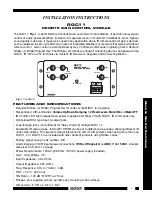
3.0 INTERFACING
3.1 INTERFACING
The main advantage of the Model 1788 is its ability to be controlled remotely, allowing the unit to be
located near the microphones, providing many sonic and operational benefits. The audio industry has
accepted for years the necessity of running microphone lines from the microphone back to the mix posi-
tion. Once at the mixing console (or dedicated microphone preamp) the microphone levels are amplified
to line levels. Advancements in digital and fiber technology with regards to audio transmissions have
created a demand for amplification of microphone levels closer to the microphones. While a fixed gain
stage may work for many applications, anyone who has mixed a live show or has done a tracking
session knows there will inevitably be adjustments made to the microphone preamps. Absent an engi-
neer riding gain at the preamps, remote control becomes a necessity.
With the 1788-R (or the 1788 Remote Program) it’s possible to create and save presets. By using presets,
gain and function settings from all connected Model 1788s in the system chain can be saved and
recalled seamlessly. Several groups of channels along with any number of individual channels can be
controlled directly from the 1788-R.
Standard MIDI, RS-232 and RS-422 communication ports are provided on the 1788-R’s external power
supply for connecting the 1788-R to a bank of Model 1788’s. No matter what port is selected the proto-
col will always be MIDI, although the communication standard will vary.
The RS-232 and RS-422 ports are functionally the same, however the length of cable that can be used is
variable. Moreover, there is a significant different in the noise immunity between the two connections.
The following table supplies the key differences of the two connectors.
Refer
to Section 3.8 (Communication Ports) in the Model 1788 User’s Guide for detailed
illustrations and pin configurations of these connections.
Using MIDI as a Secondary Control Input
On the power supply that contains all connections for interfacing the 1788-R, there is a dip switch to
select between the MIDI or RS-232/RS-422 “To Controller” port when using a secondary controller such
as a PC loaded with the proprietary 1788 Remote Program. Only the switch marked “1” is used. In the
up position, MIDI is chosen and in the down (factory default) position, RS232/RS-422 is selected.
We have including MIDI connectors on the 1788-R to provide the capability of synchronized preset
changes from a MIDI device ( such as digital mixing consoles and DAW workstations), thus making the
1788-R part of an automated show control system. In this configuration, the 1788-R is used as an inter-
face between another MIDI-based device and the Model 1788 (using RS-232/RS-422). Due to the differ-
ent baud rates between MIDI (31.25kHz) and RS-232/RS-422 (19.2kHz) care must be taken when the
1788-R is used in this fashion because communication overflow can occur.
When receiving a MIDI preset change command, the 1788-R will load the preset corresponding to the
received preset change number. This preset number will be displayed in the CURRENT display. If the
received preset number corresponds to an empty preset, the MIDI preset change command will be
ignored. MIDI preset change commands will still load a MISMATCH preset.
12
R E M O T E C O N T R O L L E R
-
R
Connection Noise Immunity Max Length
Cable Type
RS-232 Low 100 ft, 33m Null Modem
RS-422 High 3000 ft, ~1km Standard Pin-To Pin Serial
(monitor mouse extension cable)


































